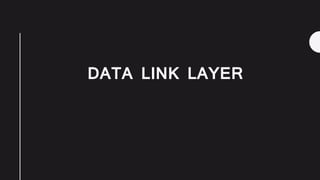
Data link layer
- 2. 2 Data flow-physical communication application transport network link physical application transport network link physical application transport network link physical application transport network link physical network link physical data data The data link layer transforms the physical layer, a raw transmission facility, to a link responsible for node-to-node (hop-to-hop) communication. DLL have a responsibilities to maintain all the capability of the sending and receiving a data
- 3. LIST OF THE DLL REQUIREMENTS/ RESPONSIBILITY'S Frame synchronization: In data link layer the data stream of bits received from the network layer into manageable data units called frames Flow control The sending station must not send frames at a rate faster then the receiving station can absorb them. Error control Any bit errors introduced by the transmission system must be checked & corrected. Addressing. On a multipoint line, such as a LAN, the identity of the two stations involved in a transmission must be specified. So will sending the data , it can add header to the frame to define the addresses of the sender and receiver of the frame. Link management. The initiation, maintenance, and termination of a data exchange requires a fair amount of
- 4. Error Detection and Correction: In network the data can be corrupted some times during transmission and some applications require that errors be detected and corrected. Some applications can tolerate a small level of error. Ex: Random errors in audio or video transmission may be tolerable, but when transfer text, expect a very high level of accuracy. “ Data can be corrupted during transmission. Some applications require that errors be detected and corrected.” Types of Errors: There are two types of errors . They are 1. Single-Bit Error 2. Burst Error The errors are like unpredictable (when data flows one node to node another, then some changes because of interference)Interference can change the shape of the signal.
- 5. Single-Bit-Error: In a single-bit error, only 1 bit in the data unit has changed. Burst Error: A burst error means that 2 or more bits in the data unit have changed. If contiguous sequence of bits in which first, last and any number of intermediate bits are in error It caused by impulse noise or by fading in wireless It may effect is greater at higher data rates .
- 6. Redundancy: The Central concept in detecting or correcting errors is redundancy To be able to detect or correct errors, need to send some extra bits with our data. These redundant bits are added by the sender and removed by the receiver. Their presence allows the receiver to detect or correct corrupted bits. “ To detect or correct errors, we need to send extra (redundant) bits with data.”
- 7. Detection vs Corrections: Detection : In error detection, to observe only if any error has occurred. Then if any single bit error is the same for us as a burst error. Correction In correction, to observe to know the exact no. of bits that are corrupted and their location in the message. The no. of errors and size of message are important. Ex: If 1 single error in an 8-bit data unit, to need to consider8 possible error locations. (for 8-bit data in a data unit of the same size to consider 28 possibilities.
- 8. Forward Error Correction Vs Retransmission: It is a part of an error correction process.Then it can be define 2 kinds of methods. 1. Forward Error Correction 2. Retransmission Forward Error Correction: It is process in which the receiver tries to guess the message by using redundant bits. Retransmission: The correction by retransmission is a technique in which the receiver detects the occurrence of an error and asks the sender to resend the message.
- 9. Coding: Redundancy is achieved through various coding schemes. The sender adds redundant bits through a process that creates a relationship between the redundant bits and the actual data bits. Then receiver checks the relationships between the two sets of bits to detect errors. The ratio of redundant bits to data bits and the robustness of the process are important factors in any coding scheme. If the coding can be divide into two broad categories: block coding and convolution coding. So to need concentrate on block coding; the convolution coding is more complex.
- 10. Block Coding: In this block coding the message can be divide into block each of k-bits called data word (dw) ‘K’. Then add ‘r’ redundant bits to each block to make the length n=k+r. The ‘n’ bits are called code word (cw). set of dw each of size is k. set of cw each of size is n. The ‘k’ bits to create a combination of 2 power k dw with ‘n’ bits to create a combination og 2 power n cw. Since n>k, the no.of possible cw is larger than the no.of possible dw. The block coding process is one-to-one; the same dw is always encoded as the same cw. This means that we have cw are not used.
- 11. Error Detection Codes Error detecting code is to include only enough redundancy allow the receiver to deduce that an error occurred, but not which error, and have it request transmission. Used in low Noisy channels- Fiber Optics Error detection uses the concept of redundancy, which means adding extra bits for detecting error at the destination. To detect an error, something extra has to be added to the data/signal This extra is an error detection code. There are types of techniques are there: Parity Check, Check Sum, CRC.
